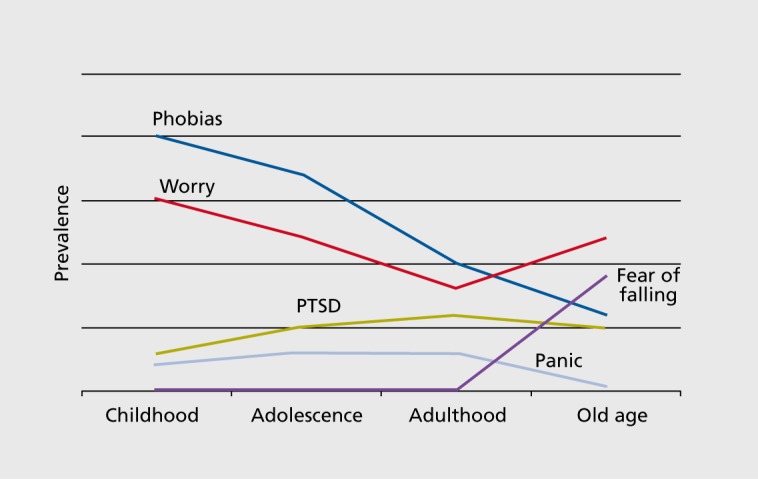- Last edited on February 26, 2021
Anxiety Disorders
Primer
Anxiety Disorders are a group of mental disorders characterized by significant feelings of anxiety and fear, including generalized anxiety disorders, specific phobias, panic disorder, and posttraumatic stress disorder. Anxiety is a worry about future events, and fear is a reaction to current events. These feelings may cause significant somatic symptoms as well.
Epidemiology
- The lifetime prevalence rates of anxiety disorders is as high as 31%.[1]
Prognosis
- Anxiety disorders can cause substantial functional impairment, quality of life issues, decreased work productivity, and a significant economic impact.[2]
Comorbidity
- Anxiety disorders are most associated with developing a comorbid major depressive disorder.
Risk Factors
- A family history of anxiety disorders, personal history of stressful life events
- Women have higher rates for most anxiety disorders compared to men.[3]
Average Age of Onset
The average age of onset varies greatly between anxiety disorders.[4]
Average Age of Onset
Adapted from: Lijster, J. M et al. (2017). The Age of Onset of Anxiety Disorders. Canadian journal of psychiatry. 62(4), 237–246.| Average age | Range | |
|---|---|---|
| Separation anxiety disorder | 11 years | 6 to 14 |
| Specific phobia | 11 years | 8 to 14 |
| Social anxiety disorder (social phobia) | 14 years | 13 to 15 |
| Agoraphobia without panic disorder | 21 years | 17 to 25 |
| Obsessive-compulsive disorder | 24 years | 19 to 29 |
| Posttraumatic stress disorder | 27 years | 22 to 31 |
| Panic disorder | 30 years | 26 to 35 |
| Generalized anxiety disorder | 35 years | 31 to 39 |
Older Adults
- Late onset anxiety disorders are relatively unusual. Thus, older patients with new onset anxiety symptoms should always have a thorough investigation for other etiologies including physical illness and medication side effects.[5]
Treatment
- The treatment of most anxiety disorders can broadly be divided into pharmacological and psychological therapies.
- Cognitive behavioural therapy is the primary treatment modality, with some modifications for specific disorders.
- Regardless of whether one takes a medication, guidelines recommend that gradual exposure to fears should be done (i.e. - exposure to decreased avoidance behaviours).[6]
Resources
For Providers
References
1)
Katzman, M. A., Bleau, P., Blier, P., Chokka, P., Kjernisted, K., & Van Ameringen, M. (2014). Canadian clinical practice guidelines for the management of anxiety, posttraumatic stress and obsessive-compulsive disorders. BMC psychiatry, 14(1), 1-83.
2)
MacQueen, G. M., Frey, B. N., Ismail, Z., Jaworska, N., Steiner, M., Lieshout, R. J., Kennedy, S. H., Lam, R. W., Milev, R. V., Parikh, S. V., Ravindran, A. V., & CANMAT Depression Work Group (2016). Canadian Network for Mood and Anxiety Treatments (CANMAT) 2016 Clinical Guidelines for the Management of Adults with Major Depressive Disorder: Section 6. Special Populations: Youth, Women, and the Elderly. Canadian journal of psychiatry, 61(9), 588–603.
3)
Katzman, M. A., Bleau, P., Blier, P., Chokka, P., Kjernisted, K., & Van Ameringen, M. (2014). Canadian clinical practice guidelines for the management of anxiety, posttraumatic stress and obsessive-compulsive disorders. BMC psychiatry, 14(1), 1-83.
4)
Lijster, J. M., Dierckx, B., Utens, E. M., Verhulst, F. C., Zieldorff, C., Dieleman, G. C., & Legerstee, J. S. (2017). The Age of Onset of Anxiety Disorders. Canadian journal of psychiatry. Revue canadienne de psychiatrie, 62(4), 237–246.
